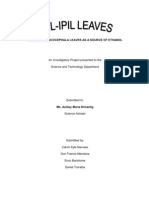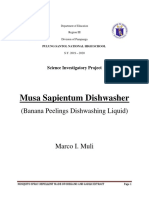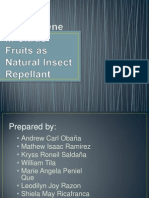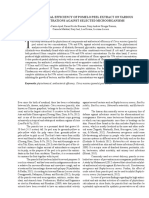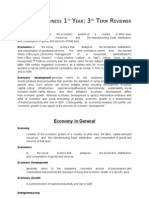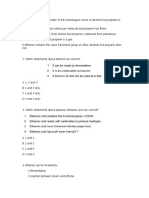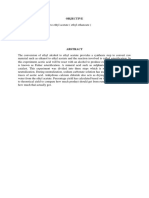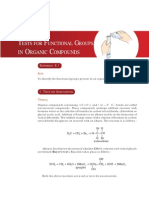Unfinished
Unfinished
Uploaded by
Daniel TorralbaCopyright:
Available Formats
Unfinished
Unfinished
Uploaded by
Daniel TorralbaCopyright
Available Formats
Share this document
Did you find this document useful?
Is this content inappropriate?
Copyright:
Available Formats
Unfinished
Unfinished
Uploaded by
Daniel TorralbaCopyright:
Available Formats
Feasibility of using Ipil-Ipil (Leucaena leucocephala) Seed Extract as Main Component to Produce Antibacterial Alcohol
An Investigatory Profect presented to the Science and Technology Department
Submitted to: Ms. Ashley Marie Dimanlig Science Adviser
Submitted by: Daniel Torralba Calvin Kyle Narvaez Don Francis Mendoza Enzo Bartolome
I Bl. Nicholas of Gesturi
CHAPTER 1 INTRODUCTION
Background of the Study Alcohols are organic molecules which form a homologous series. It has high market acceptance as medicine. Alcohol has long been widespread used as a solvent of substances intended for human contact or consumption including scents, flavourings, colourings, and medicine. It is also used as a fuel for heat, light, and for combustion engines. It is regarded as a clean fuel. Tropical countries like Philippines, has many species of tropical oil-rich trees like leucaena leucocephala commonly known as Ipil-ipil. Ipil-ipil trees are widely distributed in most localities at low and medium altitudes throughout the Philippines. Ipil-Ipil seeds have been found to contain triterpenoid alcohols1. Statement of the Problem The main problem of this study is to determine the feasibility of producing alcohol from Ipil-ipil seeds (leucaena leucocephala) extract. This study has sub-problems: 1. What will be the density of the extracted alcohol? 2. What will be the boiling point of the extracted alcohol? 3. Is the extracted alcohol soluble in water? 4. Is the extracted alcohol not soluble in salt solution? 5. Will the extracted alcohol have the same pH as that of commercial alcohol?
Antimicrobial and Pharmaceutical Properties of the Seed Oil of Leucaena leucocephala African Journal of Biomedical Research, January 2011
Hypothesis of the Study If the alcohol content of Ipil-Ipil seeds can be extracted economically and in sufficient quantity, then it can be used as alternative source for alcohol. Significance of the Study The potential use of Ipil-Ipil seeds as source for alcohol can help reduce the price of alcohol-based products to the benefit of the general population. Scopes and Limitations The researchers need to determine the physical intensive properties of the extracted alcohol such as density, solubility, pH level, boiling point, color and odor. The researchers need not use advanced test equipment such as gas chromatography or infrared spectroscopy to determine the type of alcohol extracted whether it is methanol, ethanol, propanol or others. If the intensive properties of the extracted alcohol are close to the intensive properties of commercial alcohols, these would already signify that the extracted alcohol is an acceptable antibacterial substitute for commercial alcohols.
Definition of Terms
CHAPTER II RELATED STUDIES AND LITERATURE Alcohols are clear, colourless, flammable mobile liquid that are used as antibacterial and also in antifreeze compounds in lotions and cosmetics, as solvent for shellac, gums and essential oils. Alcohols have a density of 0.785 g/ml up to 0.800 g/ml as the highest. Its boiling point is 25 degrees centigrade, and is soluble in water because alcohols can form hydrogen bonds with water. Alcohols are produced in various ways based on its type. For ethanol alcohol, the method of production is through distillation (see diagram below).
For isopropyl alcohol, the method of production is through the use of a reaction chamber tool. Isopropyl alcohol is produced by combining water and propene in ahydration reaction. There are two routes for the hydration process: indirect hydration via the sulfuric acid process, and direct hydration. The former process, which can use low-quality propene, predominates in
the USA while the latter process, which requires high-purity propene, is more commonly used in Europe2. Indicated below is a sample process for producing Ethyl Alcohol which covers hydrolysis (cooking and cooling of source materials such as starch from grain crops), fermentation and distillation3.
2 3
http://en.wikipedia.org/wiki/Isopropyl_alcohol http://journeytoforever.org/biofuel_library/ethanol_motherearth/meCh1.html
Cinnamyl alcohol is an organic compound that is found in esterified form in storax, balsam Peru and cinnamon leaves. It forms a white crystalline solid when pure, or a yellow oil when even slightly impure. It can be produced by the hydrolysis of storax.4 Hydrolysis is a chemical process in which a water molecule is added to a substance resulting in the split of that substance into two parts. One fragment of the target molecule (or parent molecule) gains a hydrogen ion (H+) from the split water molecule. The other portion of the target molecule collects the hydroxyl group (OH) of the split water molecule. In effect an acid and a base are formed. As an indicator or further proof of alcohol content from Ipil-Ipil seeds, a research study5 showed that Cinnamyl alcohol was isolated from Ipil-Ipil. Leucaena leucocephala cultivar K-636 was used for the studies and it was a selection from Hawaii (Bray et. al. 1998). The cultivar produces erect boles suitable for timber production. For regeneration and transformation experiments, embryo axis of Leucaena leucocephala was used as the ex-plant. Seeds of L. leucocephala were treated with concentrated H2SO4 for 2-3 min and then washed extensively with tap water. The scarified seeds were surface sterilized with 0.1% (w/v) HgCl2 for 10 min followed by five rinses with sterile deionized water. The seeds were soaked in sterile water for two days for imbibing. Embryo was excised from imbibed seeds and was transferred to MS basal medium (Murashige and Skoog, 1962) supplemented with 2% sucrose and 1.5% glucose. One day old excised embryos were used for the transformation experiment.
4 5
http://en.wikipedia.org/wiki/Cinnamyl_alcohol Kulakarni, P (2009) Isolation and Characterization of Cinnamyl Alcohol Dehydrogenase Gene from Leucaena Leucocephala. PhD thesis, National Chemical Laboratory, Pune, India.; http://shodhganga.inflibnet.ac.in/bitstream/10603/2443/8/08_chapter1.pdf http://shodhganga.inflibnet.ac.in/bitstream/10603/2443/9/09_chapter2.pdf
CHAPTER III METHODOLOGY
VARIABLES Independent Variable: Ipil-Ipil Seeds Dependent Variable: Alcohol Constant Variable: Amount of Ipil-Ipil Extracts
INSTRUMENTATION: Reaction Chamber, to distill and to produce the product which will be borrowed on the Science Laboratory or in other schools. Materials for testing: Triple-beam balance, to measure the products mass; Graduated Cylinder, to measure the products volume; Water, to see if the product is soluble with it; Salt Solution; to see if the product is soluble with it; Alcohol lamp, to heat the liquid of the product a to measure its boiling point. RESEARCH PROCEDURE: 1. Creating the Extract 1.1 the cartridge is equilibrated with a non-polar solvent or slightly polar, which wets the surface and penetrates the bonded phase. Then water, or buffer of the same composition as the sample, is typically washed through the column to wet the silica surface.
1.2 the sample is then added to the cartridge. As the sample passes through the stationary phase, the analytes in the sample will interact and retain on the sorbent while the solvent, salts, and other impurities pass through the cartridge. 1.3 After the sample is loaded, the cartridge is washed with buffer or solvent to remove further impurities. Then, the analyte is eluted with a non-polar solvent or a buffer of the appropriate pH. 2. Creating Alcohol: 2.1. prepare the extract, other ingredients excluding the propene ingredient, reaction chamber for the production, and rest of the ingredients in making Alcohol 2.2. place the ingredients into the reaction chamber for fermentation 2.3. gather the fermented liquid which is the alcohol 3. Testing the Product: 3.1. Measuring Density: measure the weight and volume of the product (triple-beam balance for the weight and graduated cylinder for volume) multiply the mass and the volume and subtract the mass of the graduated cylinder 3.2. Measuring the Boiling point: heat the alcohol with the alcohol lamp until it reaches the temperature of 25 degrees centigrade. If it boils, gather the data of its boiling point 3.3. Knowing the Solubility: get a glass/cup, place the water/salt solution pour the alcohol and see if the product mixes with the water/salt solution (for the water, both liquids should be dissolved or unmixed; for salt solutions, it should be mixed
You might also like
- Carbon Dioxide Scrubber RPDocument5 pagesCarbon Dioxide Scrubber RPpassionNo ratings yet
- Chapter IDocument5 pagesChapter IDaniel Torralba100% (9)
- Ls T Sdo8 Lala National High SchoolDocument34 pagesLs T Sdo8 Lala National High SchoolCarl Mathew LomingkitNo ratings yet
- Musa Sapientum Dishwasher: (Banana Peelings Dishwashing Liquid)Document9 pagesMusa Sapientum Dishwasher: (Banana Peelings Dishwashing Liquid)andrey garciaNo ratings yet
- S.I.P. Chapter 2Document4 pagesS.I.P. Chapter 2Joseph Benedict M. DeLeonNo ratings yet
- The Model For Use of Chemicals by Sugarcane Farmers For Reducing Health and Environmental Impacts in ThailandDocument5 pagesThe Model For Use of Chemicals by Sugarcane Farmers For Reducing Health and Environmental Impacts in ThailandInternational Journal of Innovative Science and Research TechnologyNo ratings yet
- Rodenticidal Property of Tubli (Derris Elliptica BenthDocument19 pagesRodenticidal Property of Tubli (Derris Elliptica BenthNoah Justine Sayson67% (3)
- Effect of Hot-Air Drying On The Physicochemical Properties of Kaffir Lime Leaves-Citrus Hystrix-LibreDocument9 pagesEffect of Hot-Air Drying On The Physicochemical Properties of Kaffir Lime Leaves-Citrus Hystrix-LibrerafeekherNo ratings yet
- C FABCON FINALEtotooHD720pDocument39 pagesC FABCON FINALEtotooHD720pChloegelo MendozaNo ratings yet
- Newton Group 7.docx 1Document6 pagesNewton Group 7.docx 1Alyssa CuellarNo ratings yet
- Review of Related Literature and StudiesDocument2 pagesReview of Related Literature and StudiesLale KezNo ratings yet
- Lemon Peel (Citrus Limon) and Lagundi (Vitex Negundo) Extracts As Potential Mosquito LarvicideDocument33 pagesLemon Peel (Citrus Limon) and Lagundi (Vitex Negundo) Extracts As Potential Mosquito LarvicideMys TiqueNo ratings yet
- Insect Repellent Property of Hagonoy and PDFDocument23 pagesInsect Repellent Property of Hagonoy and PDFJChelo RealNo ratings yet
- Mosquito Coil - US PatentDocument4 pagesMosquito Coil - US PatentKarthikSuresh100% (1)
- ResDocument15 pagesResEden Grace MorenoNo ratings yet
- DUMB CANE /DIE-FFEN-BAKYA/ (Dieffenbachia)Document8 pagesDUMB CANE /DIE-FFEN-BAKYA/ (Dieffenbachia)Jannah A. GrandeNo ratings yet
- ORGANIC-INSECTICIDES g10Document5 pagesORGANIC-INSECTICIDES g10Ann N. ArcillaNo ratings yet
- New ResearchDocument9 pagesNew Researchjesusa moranNo ratings yet
- Final Investigatory ProjectDocument6 pagesFinal Investigatory ProjectJenelyn Baguhin Budiongan0% (1)
- BIOREMEDIATION OF PULVERIZED RAMBUTAN SEEDS Nephelium Lappaceum FOR WATER PURIFICATIONDocument39 pagesBIOREMEDIATION OF PULVERIZED RAMBUTAN SEEDS Nephelium Lappaceum FOR WATER PURIFICATIONJalika ObseñaresNo ratings yet
- Group 2 Coconut CharcoalDocument16 pagesGroup 2 Coconut CharcoalSiaoNo ratings yet
- D-Limonene in Citrus Fruits As Natural Insect RepellantDocument18 pagesD-Limonene in Citrus Fruits As Natural Insect RepellantMarie Angela Peniel Que100% (1)
- Thesis Outline33334Document21 pagesThesis Outline33334LEAH MAE CANDADONo ratings yet
- Vinegar From PineappleDocument12 pagesVinegar From PineappleMarites ParaguaNo ratings yet
- Effectiveness of OreganoDocument5 pagesEffectiveness of OreganoMuhaimen SalikNo ratings yet
- Larvicidal Effect of Dalanghita (Citrus Nobilis)Document11 pagesLarvicidal Effect of Dalanghita (Citrus Nobilis)Shiki Asagami BrunestedNo ratings yet
- Kahel: Dishwashing Liquid From Orange PeelingsDocument16 pagesKahel: Dishwashing Liquid From Orange PeelingsRussel AloceljaNo ratings yet
- Dried Flower of KamansiDocument6 pagesDried Flower of KamansiJustine Lacerona100% (1)
- Feasibility of Aloe Vera (Sip)Document2 pagesFeasibility of Aloe Vera (Sip)Paupau Tolentino100% (3)
- "Leader in Academic Excellence and Values Formation": The Philippine School Abu DhabiDocument47 pages"Leader in Academic Excellence and Values Formation": The Philippine School Abu DhabianonNo ratings yet
- Mosqil RepellentDocument40 pagesMosqil RepellentjangsobriagaNo ratings yet
- Final Paper SipDocument21 pagesFinal Paper SipKimberly Delos SantosNo ratings yet
- Chapter 2 Rev Sha 812013Document36 pagesChapter 2 Rev Sha 812013Azimah HamidonNo ratings yet
- Makabuhay IpDocument7 pagesMakabuhay IpButterflyCalmNo ratings yet
- UntitledDocument15 pagesUntitledTa TenNo ratings yet
- Ipil IpilDocument12 pagesIpil Ipilthechezzmazter100% (1)
- Lester Chapter1Document4 pagesLester Chapter1Fernando AgbulosNo ratings yet
- SIP FertilizerDocument25 pagesSIP FertilizerFlory Alon HernandezNo ratings yet
- Feasibility of Malunggay As A Cleaning AgentDocument19 pagesFeasibility of Malunggay As A Cleaning AgentElloisa Pauline L. CuetoNo ratings yet
- ASEAN Journal of Science and Engineering: Carambola), and Karamay (Phyllanthus Acidus) FruitDocument4 pagesASEAN Journal of Science and Engineering: Carambola), and Karamay (Phyllanthus Acidus) FruitrjayrjayNo ratings yet
- Chapter I 3is 1Document17 pagesChapter I 3is 1doronilafatima100% (1)
- Turmeric (Cucurma Longa) Leaves Extract As Anti-Fungal SoapDocument16 pagesTurmeric (Cucurma Longa) Leaves Extract As Anti-Fungal SoapAlfie JacildoNo ratings yet
- AbstraDocument21 pagesAbstraKethlin Manimtim BignoteaNo ratings yet
- Review of Related Literature: Performance Evaluation of Corn Cob-Derived Activated Carbon On The Removal of Mercury and Lead On Contaminated WaterDocument10 pagesReview of Related Literature: Performance Evaluation of Corn Cob-Derived Activated Carbon On The Removal of Mercury and Lead On Contaminated WaterKenneth John Anthony TabagNo ratings yet
- Chapter 1 of Indigenous Microorganisms StudyDocument12 pagesChapter 1 of Indigenous Microorganisms StudyEstherr RuthNo ratings yet
- CALAMANSI RESEARCHbDocument35 pagesCALAMANSI RESEARCHbCassandra Ayesha CastilloNo ratings yet
- ResearchDocument5 pagesResearchLei Robin BolivarNo ratings yet
- Canatuan MineDocument2 pagesCanatuan MineMae BalteraNo ratings yet
- Garlic and Cacao Leaves As An Mosquito Repellent: By: Klyde Janzen S. Flores Grade 8-EarthDocument6 pagesGarlic and Cacao Leaves As An Mosquito Repellent: By: Klyde Janzen S. Flores Grade 8-EarthZandraNo ratings yet
- 11 JHS Antibacterial Efficiency of Pomelo Peel Extract On Various Concentrations Against Selected MicroorganismsDocument4 pages11 JHS Antibacterial Efficiency of Pomelo Peel Extract On Various Concentrations Against Selected MicroorganismsTriesha GervacioNo ratings yet
- 1 and 2Document28 pages1 and 2Alyssa RanolaNo ratings yet
- Final PaperDocument48 pagesFinal PaperCharissa Anne LogronioNo ratings yet
- Utilization of Bubalus Bubalis Carabenesis Ordure As Biotic DeodorizerDocument32 pagesUtilization of Bubalus Bubalis Carabenesis Ordure As Biotic DeodorizerIyan Machu FlowersNo ratings yet
- Manuscript FinalDocument44 pagesManuscript FinalLoulou ApolloNo ratings yet
- Herbal Plants As An Ant Repellent 246-242-1-PbDocument4 pagesHerbal Plants As An Ant Repellent 246-242-1-Pbsiu manmanNo ratings yet
- Pampanga High School: LARVICIDAL ACTIVITY OF PANSIT-PANSITAN (Peperomia Pellucida) Leaf Extract Against Aedes AegyptiDocument12 pagesPampanga High School: LARVICIDAL ACTIVITY OF PANSIT-PANSITAN (Peperomia Pellucida) Leaf Extract Against Aedes AegyptiGinaNo ratings yet
- Acceptability of Pomelo Peel As Mosquito Coil Paper PPT Final Defense GREENDocument48 pagesAcceptability of Pomelo Peel As Mosquito Coil Paper PPT Final Defense GREENJames AndeaNo ratings yet
- Lansium Domesticum Corr. Leaf Extract Spray As Bioinsecticide For Aedes Aegypti Mosquito ControlDocument9 pagesLansium Domesticum Corr. Leaf Extract Spray As Bioinsecticide For Aedes Aegypti Mosquito ControlPeterson RonquilloNo ratings yet
- Physical and Chemical Properties of Organic Fertilizer From Banana (Musa Paradisiaca) Leaf and Stem With Effective Microorganism Activactors (EM4)Document5 pagesPhysical and Chemical Properties of Organic Fertilizer From Banana (Musa Paradisiaca) Leaf and Stem With Effective Microorganism Activactors (EM4)International Journal of Innovative Science and Research TechnologyNo ratings yet
- Production and Purification of Alcohol From Fermentation of Nira Aren (Arenga Pinnata Merr)Document5 pagesProduction and Purification of Alcohol From Fermentation of Nira Aren (Arenga Pinnata Merr)IJAERS JOURNALNo ratings yet
- Characterization and Antioxidant Activity of Nocino LiqueurDocument8 pagesCharacterization and Antioxidant Activity of Nocino LiqueurJasper AorangiNo ratings yet
- Review of Related Literature and StudiesDocument1 pageReview of Related Literature and StudiesDaniel TorralbaNo ratings yet
- KapatiranDocument3 pagesKapatiranDaniel TorralbaNo ratings yet
- I.P. CH-II RRSL: Concrete BlocksDocument1 pageI.P. CH-II RRSL: Concrete BlocksDaniel TorralbaNo ratings yet
- T.L.E. - Business 3rd Term ReviewerDocument12 pagesT.L.E. - Business 3rd Term ReviewerDaniel TorralbaNo ratings yet
- SoS and DoTDocument2 pagesSoS and DoTDaniel TorralbaNo ratings yet
- 5S Utility Box PresentationDocument6 pages5S Utility Box PresentationDaniel TorralbaNo ratings yet
- Panel 6Document1 pagePanel 6Daniel TorralbaNo ratings yet
- Feasibility of IpilDocument1 pageFeasibility of IpilDaniel TorralbaNo ratings yet
- Chapter IIDocument2 pagesChapter IIDaniel TorralbaNo ratings yet
- The Role of Chemistry in Sanitization and Personal Hygiene in Context of Covid-19Document8 pagesThe Role of Chemistry in Sanitization and Personal Hygiene in Context of Covid-19Central Asian StudiesNo ratings yet
- Introduction - Wine Market in India - Swot Analysis - Summary - QueriesDocument6 pagesIntroduction - Wine Market in India - Swot Analysis - Summary - QueriesAnuj VermaNo ratings yet
- How To Extract DNA From FruitsDocument12 pagesHow To Extract DNA From FruitsappleaimiNo ratings yet
- 02 Alcohol and Carboxylic Acid QPDocument7 pages02 Alcohol and Carboxylic Acid QPcharlesma123No ratings yet
- Methanol Iran Spec F Grade SpecificationDocument2 pagesMethanol Iran Spec F Grade SpecificationDnieper TradeNo ratings yet
- Chemistry Criterion D ResearchDocument7 pagesChemistry Criterion D ResearchNjeri GichangiNo ratings yet
- X Study Material Final ModifiedDocument317 pagesX Study Material Final Modifieddevisree100% (1)
- The Cause and Effect of Drinking Alcohol Among Students of BNHSDocument77 pagesThe Cause and Effect of Drinking Alcohol Among Students of BNHSAsis Jean Paula SegueraNo ratings yet
- PHCT LabDocument7 pagesPHCT LabsherilleNo ratings yet
- Science of The Total EnvironmentDocument9 pagesScience of The Total EnvironmentAyesha KhanNo ratings yet
- Alcohol Chemistry: Alcoholic Drinks (Ethanol) Solvents FuelsDocument17 pagesAlcohol Chemistry: Alcoholic Drinks (Ethanol) Solvents FuelsSubhash DhungelNo ratings yet
- CETD-II Tutorial 8Document2 pagesCETD-II Tutorial 8Tanmay GoyalNo ratings yet
- Q1 Module1B Properties-Of-Liquids v5Document23 pagesQ1 Module1B Properties-Of-Liquids v5Mikaela EuniceNo ratings yet
- Phenyl Ethyl Alcohol PDFDocument18 pagesPhenyl Ethyl Alcohol PDFTua HalomoanNo ratings yet
- Organic Groups LaboratoryDocument8 pagesOrganic Groups LaboratoryAna Sofia Guzman FernandezNo ratings yet
- AlcoholsDocument74 pagesAlcoholsSmit PatelNo ratings yet
- Alkyl Benzene Sulphonic AcidDocument17 pagesAlkyl Benzene Sulphonic AcidZiauddeen Noor100% (1)
- Lab Report 3Document9 pagesLab Report 3ainnor100% (1)
- Extraction FAQDocument18 pagesExtraction FAQDaria SchkaNo ratings yet
- Distinction Test (Organic Chemistry)Document14 pagesDistinction Test (Organic Chemistry)Ashish Kumar100% (3)
- Alcoholic Beverages - Methods of Sampling and Test: Kenya StandardDocument79 pagesAlcoholic Beverages - Methods of Sampling and Test: Kenya StandardMarko Andric AndraNo ratings yet
- Important Questions For Class 12 Chemistry Chapter 11 - Alcohols, Phenols and Ethers Class 12 Important QuestionsDocument3 pagesImportant Questions For Class 12 Chemistry Chapter 11 - Alcohols, Phenols and Ethers Class 12 Important Questionsvk0595142No ratings yet
- ERAVAP Cleaning ProcedureDocument2 pagesERAVAP Cleaning ProceduresamNo ratings yet
- January 2013 QP - Unit 2 AQA Chemistry A-LevelDocument24 pagesJanuary 2013 QP - Unit 2 AQA Chemistry A-LevelFidelius ArkusNo ratings yet
- Chemical CompoundsDocument33 pagesChemical CompoundsHajellah AmpasoNo ratings yet
- Formulation and Evaluation of Lotion and Cream of Nanosized Chitosan-Mangosteen (Garcinia Mangostana L.) PERICARP EXTRACTDocument7 pagesFormulation and Evaluation of Lotion and Cream of Nanosized Chitosan-Mangosteen (Garcinia Mangostana L.) PERICARP EXTRACTKandida Hilda NovikaNo ratings yet
- III (ForDocument6 pagesIII (ForChristine Yaco DetoitoNo ratings yet
- A02 099Document20 pagesA02 099jaimeNo ratings yet
- ch-4 science AKDocument3 pagesch-4 science AKsreenanda1611No ratings yet

